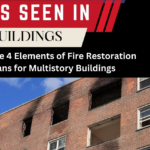
4 Elements of Fire Restoration Plans for Multistory Buildings
October 27, 2023
Understanding the impact of smoke damage on fire-ravaged buildings
November 14, 2023Understanding the impact of smoke damage on fire-ravaged buildings
THE OFFICIAL MONTHLY NEWS MAGAZINE OF THE NATIONAL ASSOCIATION OF RESIDENTIAL PROPERTY MANAGERS
Written by Ron Fanish, Co-Owner of Rainbow Intl Restoration of Westchester

For most residential property managers, a fire is the biggest challenge you can face. A blaze is a unique and dangerous incident, endangering residents and potentially causing catastrophic damage. Even when residents are evacuated and the flames are extinguished, some of the most difficult tasks lie ahead. Indeed, the aftermath of a fire — particularly the impact of smoke damage — is often underestimated by property managers. To effectively recover from a fire, it's essential for residential property managers to fully understand how smoke damage can affect a building and how to best address it. Only then is it possible to move ahead with all the necessary repairs and restorations and return the property to its pre-disaster state. Here are four key facts to know about the impact of smoke damage. The severity of these impacts can vary based on the size of the fire and volume of smoke, but they are all common in the aftermath of a fire. No property manager wants to have to use this information — but in the event of a disaster, you'll be glad you know it.
Smoke can be destructive.
While the destruction caused by flames tends to be more obvious damage, smoke can also do serious damage to a house or apartment. It can stain drywall, ruin ceilings, taint insulation and permanently change the color of walls. Indeed, smoke damage is not something that's easily scrubbed off with a brush, soap and some elbow grease. Smoke particles deeply permeate materials, often making replacement necessary. Fortunately, new technologies like laser cleaning make smoke remediation less taxing and can help salvage many surfaces.
Some smoke damage is invisible.
Not all smoke damage is easily spotted — some of the destruction it causes is invisible. Smoke can be especially damaging to delicate electronic equipment like televisions, microwaves, computers and other common appliances. It infiltrates the devices and damages components, causing short circuits. Smoke can also get into mechanical devices a building’s HVAC system, fans or heat sinks. This may affect future air quality or even break the systems outright. All of this might not be obvious until well after the fire is out, so it's important for property managers to test all electrical and mechanical appliances and systems in an affected building.
Few materials are immune to smoke damage.
Property managers might think some materials, like steel and other metal, are exempt from smoke damage. But that's not the case. Smoke can take a heavy toll on metals, tarnishing their surface or possibly corroding it. Smoke’s fine particles can bind to metals, building up and discoloring a metal’s surface. And smoke’s chemical composition — sulfur dioxide and nitrogen oxides — can rust and degrade many metals. In addition to sheetrock and wood, check all metal surfaces and materials. They need to be cleaned and remediated, too.
Smoke damage can linger.
Even if smoke doesn't have a negative cosmetic impact on a property, it can render the space unlivable through odor. Smoke leaves a greasy coating on cabinets, countertops and pretty much any other surface. It also comes with a strong smell. This distinct odor can linger for a long time, especially in carpets, rugs, upholstered furniture and other fabrics. Property managers must ensure proper ventilation and deploy methods to effectively remove the odor from a building. A box of baking soda won’t do the trick. Oftentimes commercial odor removal is required. No one wants to think about a fire and the damage it can bring to a building. But it's essential to be prepared. Understanding the impact of smoke damage is key to disaster preparation. Armed with the above information, property managers will be better equipped to act in the wake of a disaster. Working alongside trained and certified restoration profes-sionals, they can ensure their tenants’ wellbeing and recover from the challenge more swiftly than otherwise possible




